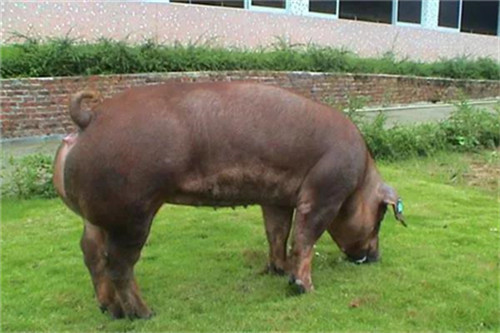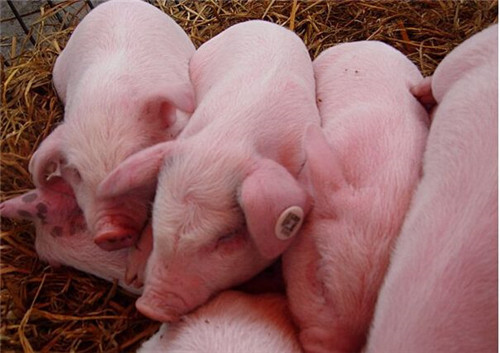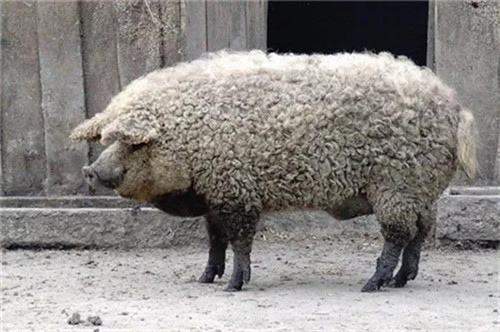Porcine reproductive and respiratory disorders syndrome
Porcine reproductive and respiratory syndrome (PRRS) is a contagious disease caused by porcine reproductive and respiratory syndrome virus. Pigs of all ages can be infected. The main clinical features of the disease are reproductive disorders of sows and respiratory symptoms of piglets. Infected pig farms in the absence of secondary infection, pigs generally do not have clinical symptoms.
I. pathogen
The pathogen of this disease is a kind of RNA virus with envelope of arteritis virus family and arteritis virus, which is oval in shape, with a diameter between 40~60nm and protuberances about the size of 5nm on the surface.
The resistance of the virus to the external environment is relatively weak, and mutation is a very obvious feature of RNA virus. The variation of PRRSV genome is one of the important reasons why the disease is difficult to control.
The virus has a strong immunosuppressive effect. In the epidemic stage of the disease, the infected pigs are in the stage of viremia, which is often one of the main reasons for the failure of classical swine fever immunity.
All the isolates of porcine reproductive and respiratory syndrome virus in China belong to American type, and no European type strain has been found so far. At the same time, there are mutations in Chinese isolates, and it has been found that there are deletion variants.
II. Epidemiology
1. Susceptible animal
Pigs of all ages and types can be infected, but pregnant sows and piglets are the most susceptible and show typical clinical symptoms.
two。 Source of infection
Infected pigs and infected pigs are the source of infection. various secretions, nose juice, urine, feces and breathing gases of infected pigs all contain virus, and tolerant pigs can excrete virus for a long time.
3. Ways of transmission
Air transmission, vertical transmission, etc.
4. Popular characteristics
Strong variability, fast transmission, serious pollution, once it occurs, it is difficult to purify, after the onset of the disease may be repeated for several months or years.

III. Clinical symptoms
The incubation period of PRRS in susceptible pigs after introduction of infection was 3 days and 37 days respectively. The clinical symptoms of the disease vary greatly and are affected by virus strains, immune status, feeding and management factors and environmental conditions. The clinical manifestations of pigs in different stages are different.
1. The main manifestations of sows were depression, loss of appetite or abstinence, fever, dyspnea in varying degrees, abortion, premature delivery, stillbirth, mummified fetus and weak baby in the later stage of pregnancy (105-107 days). The abortion rate of sows can reach 50%-70%, the stillbirth rate can reach more than 35%, and mummies can reach 25%. Some newborn piglets show symptoms such as dyspnea, dyskinesia and paralysis, and the mortality rate increases significantly within 1 week after delivery (40%-80%). A few sows showed no milk after delivery, stagnation of placenta and increase of vaginal secretion.
2. 1-month-old piglets showed typical respiratory symptoms, dyspnea, sometimes abdominal breathing, loss of appetite or abstinence, body temperature above 40 ℃ and diarrhea. Rough coat, ataxia, progressive emaciation, eyelid edema. A small number of piglets can see purple skin on their ears and body surface, and the mortality rate of piglets before weaning can reach 80%-100%. After weaning, the weight gain of piglets decreases, the daily gain decreases by 50%-75%, and the mortality increases (10%-25%). It has been resistant to slow growth of pigs and is prone to other diseases.
3. Growing pigs and fattening pigs showed mild clinical symptoms with different procedures of respiratory symptoms. A few cases showed cough and dark purple skin on the back, edge, abdomen and tail of both ears. Infected pigs are prone to secondary infection and corresponding symptoms.
4. The incidence of breeding boar is low, which is mainly manifested as general clinical symptoms, but the semen quality of boar decreases, sperm deformity, semen can be poisonous.
IV. Pathogenesis
The virus mainly attacks the macrophages of pigs, resulting in the decline of immune function, and sick pigs are prone to secondary infection of various diseases. The specific target cell of this virus is pulmonary macrophage. once the immune function of respiratory system is decreased, inflammation occurs when the respiratory mucous membrane microorganism is immersed into the lung.
5. Pathological changes
The main lesions occurred in the respiratory system and lymphoid tissue, and the lungs showed reddish-brown speckles and did not collapse. The main microscopic lesions were interstitial diffuse pneumonia, alveolar wall thickening, pulmonary interstitial widening, alveolar and alveolar diaphragm edema and inflammatory cell infiltration. The lymph nodes were enlarged and some of the lungs adhered to the pleura.
VI. Diagnosis
It is difficult to make a judgment only according to the clinical manifestations, epidemiological characteristics and pathological changes, and the diagnosis must be made by laboratory testing technology. Laboratory diagnosis mainly includes serological diagnosis, pathogen isolation and identification, RT-PCR detection and other methods.
VII. Disease prevention and control
1. Adhere to the principle of self-breeding and self-raising, establish a stable breeding herd, and do not introduce easily. If it must be introduced, we must first find out the epidemic situation of the pig farm, in addition, serological testing should be carried out, negative pigs should be introduced, and the introduction of positive pigs with virus should be resolutely prohibited. After the introduction, a proper isolation area must be established and the monitoring work must be done well. Generally, quarantine and quarantine are required for 4 or 5 weeks before healthy people can be raised in mixed groups.
2. Large-scale pig farms should completely realize all-in and all-out, at least in the two stages of delivery room and conservation.
3. Establish and improve the biosafety system of large-scale pig farms, disinfect pig houses and environment regularly, and keep pig houses, feeding and management appliances and environment clean and hygiene. on the one hand, it can prevent the spread of epidemic disease outside, on the other hand, through strict sanitary disinfection measures to reduce the pollution of pathogenic microorganisms in pig farms to the minimum, which can control and reduce the incidence of PRRSV infection and the chance of secondary infection.
4. Do a good job in pig feeding and management. In the pig farms infected with porcine reproductive and respiratory syndrome virus, the feeding and management of pigs in all stages should be done well, and good materials should be used to ensure the nutritional level of pigs, so as to improve their resistance to other pathogenic microorganisms. so as to reduce the incidence of secondary infection and the resulting loss.
5. Do a good job of immunization against other diseases and control other diseases, especially classical swine fever, swine pseudorabies and porcine asthma. In pig farms infected with porcine reproductive-respiratory syndrome virus, we should try our best to control classical swine fever, otherwise it will cause high mortality of pigs; at the same time, we should try our best to promote the immunization of porcine asthma vaccine to reduce the damage of Mycoplasma hyopneumoniae to the lungs, so as to improve the resistance of pig lungs to respiratory pathogens infection.
6. The infection status of porcine reproductive and respiratory syndrome virus in pig herds was monitored regularly in order to understand the activity of the disease in pig farms. Generally speaking, once a quarter, pig herds at all stages are sampled for antibody monitoring. If the antibody positive rate does not change significantly for 4 times, it shows that the disease is stable in pig farms. On the contrary, if the antibody positive rate increases in a certain quarter, it shows that there are problems in pig farm management and sanitary disinfection. It should be corrected.
7. Close blockade of diseased pig farms; certain measures should also be taken to avoid the spread of diseases, harmless treatment of aborted placentas, stillbirths and dead pigs, thorough disinfection of delivery rooms, isolation of diseased pigs and symptomatic treatment, improve feeding conditions and so on.
8. With regard to vaccination, generally speaking, there are no very effective immune control measures. Commercial PRRS attenuated vaccines and inactivated vaccines have been launched at home and abroad, and there are also officially approved inactivated vaccines in China. However, the phenomenon of increased atavistic virulence and safety of PRRS attenuated vaccine has increasingly aroused people's concern. Attenuated vaccines have caused many outbreaks of PRRS in pigs at home and abroad, so live vaccines should be used cautiously. (source: song Yongxiang Animal Research Test)
- Prev

Do you know how to treat the nutritional diarrhea of weaned piglets?
Do you know how to treat the nutritional diarrhea of weaned piglets?
- Next

4-day-old piglets have neurological symptoms, case sharing + prevention and treatment plan
4-day-old piglets have neurological symptoms, case sharing + prevention and treatment plan
Related
- On the eggshell is a badge full of pride. British Poultry Egg Market and Consumer observation
- British study: 72% of Britons are willing to buy native eggs raised by insects
- Guidelines for friendly egg production revised the increase of space in chicken sheds can not be forced to change feathers and lay eggs.
- Risk of delay in customs clearance Australia suspends lobster exports to China
- Pig semen-the Vector of virus Transmission (4)
- Pig semen-the Vector of virus Transmission (3)
- Five common causes of difficult control of classical swine fever in clinic and their countermeasures
- Foot-and-mouth disease is the most effective way to prevent it!
- PED is the number one killer of piglets and has to be guarded against in autumn and winter.
- What is "yellow fat pig"? Have you ever heard the pig collector talk about "yellow fat pig"?

